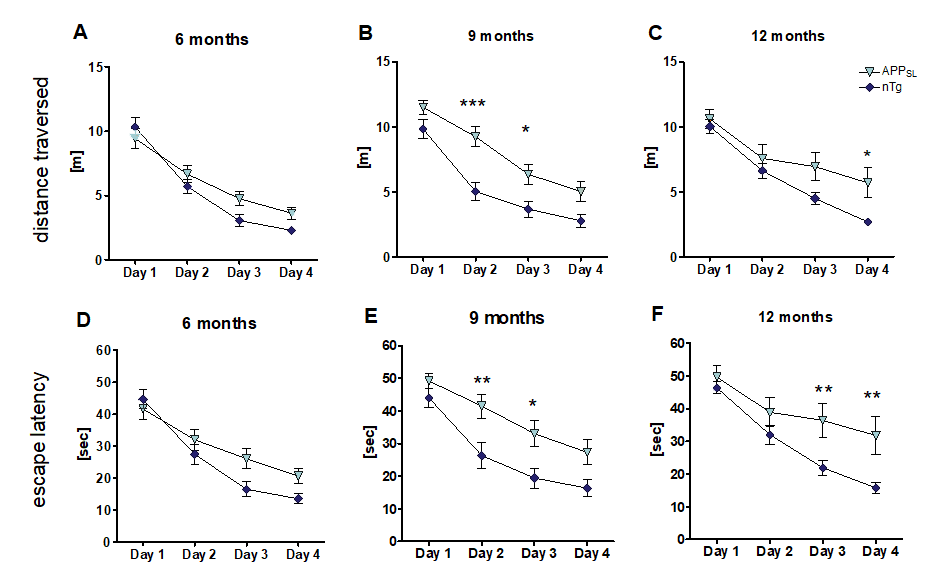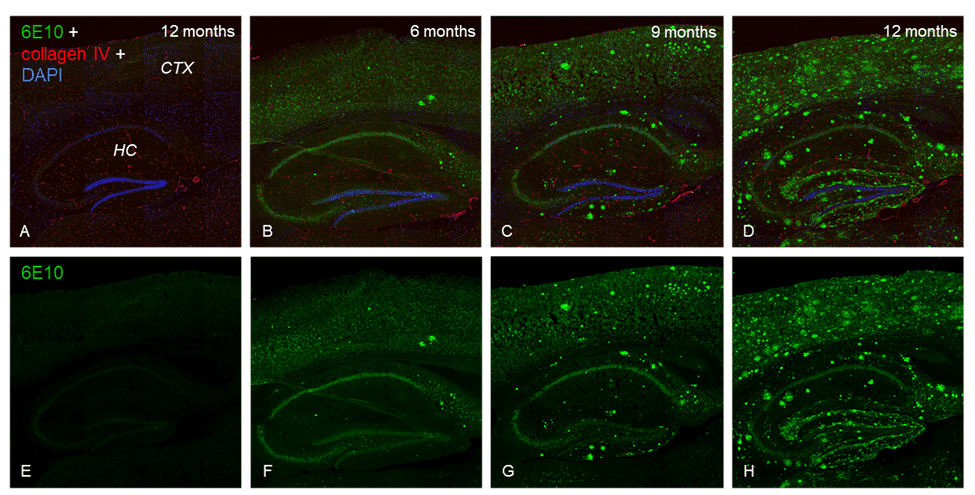Alzheimer’s disease (AD) is the most common cause of dementia and an age-associated neurodegenerative disorder. The main and mostly studied pathology of AD is the aggregation of amyloid beta (Aβ) in the brain resulting in clinical characteristics of progressive cognitive decline in affected people. Based on these facts, AD research mainly focuses on developing therapeutic strategies interrupting amyloid aggregation. To test newly developed compounds, appropriate models are required. The APP transgenic mice are frequently used for efficacy studies and represent behavioral and pathological symptoms. APPSL transgenic mice overexpress human APP751SL under the control of the murine Thy1 promoter. This human APP with London (717) and Swedish (670/671) mutations is expressed in high levels, resulting in an age-dependent increase of Aβ1-40 and -42. Starting at 3 – 6 months, APPSL mice develop plaques consisting of Aβ depositions in the frontal cortex.
Cognitive deficits of these mice start at 9 to 10 months of age. Additionally, APPSL animals present with severe neuroinflammation and oxidative stress starting as early as 6 and 9 months of age, respectively. This model presents an unchanged motor performance.
The most important characteristics of APPSL mice are:
- Increase of Aβ in cortex and hippocampus
- Aggregated Aβ accumulations
- Increased oxidative stress
- Increased neuroinflammation
- Increased phosphorylated tau (ptau)
- Spatial and long-term memory deficits

Figure 1: Assessment of spatial learning in the Morris water maze showing distance traversed and escape latencies during 4 testing days of 6 (A, D), 9 (B, E) and 12-months (C, F) old APPSL (orange) and non-transgenic (nTg, blue) animals. n = 13-21. Mean ± SEM. Two-way ANOVA with Bonferroni ‘s post hoc test compared to nTg. *p<0.05; **p<0.01; ***p<0.001.

Figure 2: Qualitative comparison of APPSL transgenic mice at 6, 9 and 12 months of age vs. a 12 months old non transgenic animal. Images show examples of immunofluorescent labeling of 6E10 (green) and collagen IV (red) on brain sections of a APPSL transgenic mouse at 6 (column 2 – B, F), 9 (column 3 – C, G) and 12 months (column 4 -D, H) of age compared to a 12 months old non-transgenic animal (column 1 – A, E); nuclei are labeled with DAPI (blue).
Scantox offers a custom-tailored study design for APPSL mice, and we are flexible to accommodate your special interests. We are also happy to advise you and propose study designs. APPSL mice show relevant features of AD already at 6-9 months of age. Based on various options to study APPSL mice, your study will be customized according to your requirements. Furthermore, wild type littermates are available as control animals needed for proper study design.
We are happy to evaluate the efficacy of your compound in the APPSL mouse model! The most common readouts are:
- Aβ aggregate levels
- Neurofilament light chain (NF-L) levels
- Cytokine levels
- Aβ and Aβ plaque load
- Tau phosphorylation levels
- Learning deficits and memory loss
